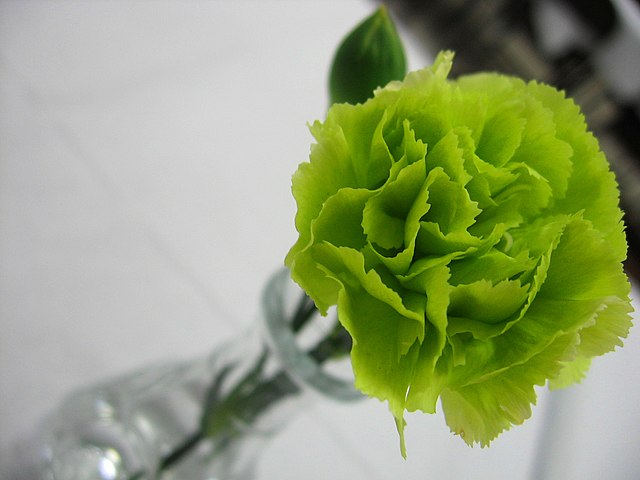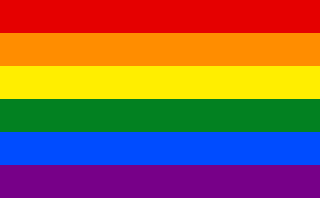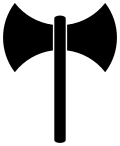LGBTQ symbols
Flags and symbols used by the LGBTQ community From Wikipedia, the free encyclopedia
Over the course of its history, the LGBTQ community has adopted certain symbols for self-identification to demonstrate unity, pride, shared values, and allegiance to one another. These symbols communicate ideas, concepts, and identity both within their communities and to mainstream culture. The two symbols most recognized internationally are the pink triangle and the rainbow flag.[1][2][3]
Letters and glyphs
Summarize
Perspective
Gender symbols

The female and male gender symbols are derived from the astronomical symbols for the planets Venus and Mars respectively. Following Linnaeus, biologists use the planetary symbol for Venus to represent the female sex, and the planetary symbol for Mars to represent the male sex.
Two interlocking female symbols (⚢) represent a lesbian or the lesbian community, and two interlocking male symbols (⚣) a gay male or the gay male community.[4][5] These symbols first appeared in the 1970s.[5]
The combined male-female symbol (⚦) is used to represent androgyne or transgender people; when additionally combined with the female (♀) and male (♂) symbols (⚧) it indicates gender inclusivity, though it is also used as a transgender symbol.[6][7]
Lambda

In 1970, graphic designer Tom Doerr selected the lower-case Greek letter lambda (λ) to be the symbol of the New York chapter of the Gay Activists Alliance.[8][9] The alliance's literature states that Doerr chose the symbol specifically for its denotative meaning in the context of chemistry and physics: "a complete exchange of energy–that moment or span of time witness to absolute activity".[8]
The lambda became associated with gay liberation,[10][11] and in December 1974, it was officially declared the international symbol for gay and lesbian rights by the International Gay Rights Congress in Edinburgh, Scotland.[12] The gay rights organization Lambda Legal and the American Lambda Literary Foundation derive their names from this symbol.
Plants and animals
Summarize
Perspective

The color lavender and the eponymous plant are symbols of LGBT+ identity. This has led to the naming of terms such as Lavender Scare and Lavender Marriage.[13][14][15]


In 19th century in England, green indicated homosexual affiliations, as popularized by queer author Oscar Wilde, who often wore a green carnation on his lapel.[16][17] According to some interpretations, American poet Walt Whitman used the sweet flag plant to represent homoerotic male love because of its phallic connotations.[18]

The term bara (薔薇), "rose" in Japanese, has historically been used in Japan as a pejorative for men who love men, roughly equivalent to the English language term "pansy".[19][20]: 40 Beginning in the 1960s, the term was reappropriated by Japanese gay media: notably with the 1961 anthology Ba-ra-kei: Ordeal by Roses, a collection of semi-nude photographs of homosexual writer Yukio Mishima by photographer Eikoh Hosoe,[20]: 34 and later with Barazoku (薔薇族, lit. "rose tribe") in 1971, the first commercially produced gay magazine in Asia.[21] The use of the rose as a prominent symbol of love between males is supposedly derived from the Greek myth of King Laius having affairs with boys under rose trees.[22] Since the 2000s, bara has been used by non-Japanese audience as an umbrella term to describe a wide variety of Japanese and non-Japanese gay media featuring love and sex between masculine men.[23] The rose is also the sacred flower of Eros,[24] the Greek god of love and sex, and patron of love between men.[25] Eros was responsible for the first rose to sprout on Earth, followed by every flower and herb.[26] Roses are a symbol of pederasty in ancient Greece: handsome boys were metaphorically called roses by their male admirers in homoerotic poems such as those by Solon, Straton, Meleager, Rhianus, and Philostratos.[27]
Animals that lovers gave as gifts to their beloved also became symbols of pederastic love, such as hares, roosters, deer, felines and oxen, as a metaphor for sexual pursuits.[28][29]

Violets and their color became a special code used by lesbians and bisexual women.[30][31][32] The symbolism of the flower derives from several fragments of poems by Sappho in which she describes a lover wearing garlands or a crown with violets.[33][34] In 1926, the play La Prisonnière by Édouard Bourdet used a bouquet of violets to signify lesbian love.[35] When the play became subject to censorship, many Parisian lesbians wore violets to demonstrate solidarity with its lesbian subject matter.[36]

White lilies have been used since the Romantic era of Japanese literature to symbolize beauty and purity in women, and are a de facto symbol of the yuri genre (yuri (百合) translates literally to "lily"),[37] which describes the portrayal of intimate love, sex, or emotional connections between women.[38] The term Yurizoku (百合族, lit. "lily tribe") was coined in 1976 by Ito Bungaku, editor of the gay men's magazine Barazoku (see above), to refer to his female readers.[39][40] While not all those women were lesbians, and it is unclear whether this was the first instance of the term yuri in this context, an association of yuri with lesbianism subsequently developed.[41] In Korea and China, "lily" is used as a semantic loan from the Japanese usage to describe female-female romance media, where each use the direct translation of the term – baekhap (백합) in Korea[42] and bǎihé (百合) in China.[43]

In the late 1990s, activist Michael Page established the use of the Trillium flower as a symbol of bisexuality. This was a pun, as scientists had used the term "bisexual" to refer to the flowers because they had both male and female reproductive organs.[46] Trillum's use as a bisexual symbol has been reaffirmed by artists and graphic designers such as Francisco Javier Lagunes Gaitán and Miguel Angel Corona, who designed a Mexican variant of the bisexual pride flag emblazoned with a white trillium.[47][48][49]

Sexual fluidity and abrosexuality --terms that refer to a changing sexual orientation that can't always be consistently described-- are represented by the watermelon. Because it is composed primarily of water, the watermelon symbolizes a sexuality that is fluid.[50][51]
Blåhaj

The IKEA plush toy shark Blåhaj (stylized BLÅHAJ, Swedish pronunciation: [ˈblôːhaj] ⓘ, lit. 'blue shark'; colloquially anglicised as /ˈblɑːhɑːʒ/, /ˈblɑːhɑː/ or /ˈbloʊhaɪ/) is commonly associated with LGBTQ culture, in particular the transgender community, in part due to being colored similarly to a transgender pride flag.[52] Early origins of this are traced back to around 2020 and in 2021 IKEA ran an ad-campaign to support same-sex marriage in Switzerland featuring the shark.[53]
In response to this popularity, IKEA Canada hosted a giveaway in November 2022, offering transgender people a special edition Blåhaj in the colors of a transgender pride flag, with the winner's name embroidered on its fin.[54]
Lavender rhinoceros

Daniel Thaxton and Bernie Toale created a lavender rhinoceros symbol for a public ad campaign to increase visibility for gay people in Boston helmed by Gay Media Action-Advertising; Toale said they chose a rhinoceros because "it is a much maligned and misunderstood animal" and that it was lavender because that is a mix of pink and blue, making it a symbolic merger of the feminine and masculine. (Lavender had already been used to represent LGBTQ people in other contexts).[55][56][57] However, in May 1974, Metro Transit Advertising said its lawyers could not "determine eligibility of the public service rate" for the lavender rhinoceros ads, which tripled the cost of the ad campaign. Gay Media Action challenged this but were unsuccessful. The lavender rhinoceros symbol was seen on signs, pins, and t-shirts at the Boston Pride Parade later in 1974, and a life-sized papier-mâché lavender rhinoceros was part of the parade. Money was raised for the ads, and they began running on the Massachusetts Bay Transportation Authority's Green Line by December 3, 1974, and ran there until February 1975. The lavender rhinoceros continued as a symbol of the gay community, appearing at the 1976 Boston Pride Parade and on a flag that was raised at Boston City Hall in 1987.[58]
Outside of Boston, Theatre Rhinoceros, located in San Francisco, and founded in 1977, based its name on this symbol.[59] Theatre Rhinoceros, also called Theatre Rhino, or The Rhino, is a gay and lesbian theatre.[60] It claims to be the world's longest-running professional queer theatre company.[61] An online bookstore focused on LGBTQ authors and books called "The Lavender Rhino" launched in 2023.[62]
Unicorn

Unicorns have become a symbol of LGBTQ culture due to earlier associations between the animal and rainbows being extended to the rainbow flag created in 1978 by Gilbert Baker.[63]
Alice Fisher of The Guardian wrote in 2017, "The unicorn has also done its bit for the LGBT community in the last century... Rainbows and unicorns are so intrinsically linked (the association is also a Victorian invention) that it's unsurprising that the magic creature started to appear on T-shirts and banners at Gay Pride around the world, with slogans such as 'Gender is Imaginary' or 'Totally Straight' emblazoned under sparkling rainbow unicorns."[64]
Gay Star News said in 2018 that unicorns are the "gay, LGBTI and queer icons of our time".[65]
Butterfly
Due to the metamorphosis from caterpillar to butterfly, butterflies are often used as symbols of transformation. Because of this, they can symbolize gender transition and transgender identity.[66]
- A transgender butterfly symbol.
- The Mormon Fritillary, a butterfly that undergoes a natural gender transition from male to female.[67]
Other symbols
Summarize
Perspective
Symbols of the LGBTQ community have been used to represent members' unity, pride, shared values, and allegiance to one another.
Triangle badges of Nazi Germany
One of the oldest of these symbols is the downward-pointing pink triangle that male homosexuals, male bisexuals, and transgender women in Nazi concentration camps were required to wear on their clothing. The badge is one of several badges that internees wore to identify what kind of prisoners they were.[68] Many of the estimated 5,000–15,000 gay men imprisoned in concentration camps did not survive.[69] The pink triangle was later reclaimed by gay men, as well as some lesbians, in various political movements as a symbol of personal pride and remembrance.[70][71] AIDS Coalition to Unleash Power (ACT-UP) adopted the downward-pointing pink triangle to symbolize the "active fight back" against HIV/AIDS "rather than a passive resignation to fate."[72]
The pink triangle was used exclusively with male prisoners, including transfeminine individuals, as cisgender lesbians were not included under Paragraph 175, a statute which made homosexual acts between males a crime.[73] Lesbian sexual relations were illegal only in Austria and historians differ on whether they were persecuted or not, due to lack of evidence.[74] Some lesbians were imprisoned with a black triangle symbolizing supposed "asociality", this symbol was later reclaimed by postwar lesbians.[71]
- Pink Triangle
The downward-pointing pink triangle used to identify homosexual men and transgender women in the concentration camps. - Jewish Pink Triangle
The downward-pointing pink triangle overlapping a yellow triangle was used to single out male homosexual prisoners who were Jewish.
Biangles

The biangles symbol of bisexuality was designed by artist Liz Nania, as she co-organized a bisexual contingent for the Second National March on Washington for Lesbian and Gay Rights in 1987.[75][76] The design of the biangles began with the pink triangle, a Nazi concentration camp badge that later became a symbol of gay liberation representing homosexuality. The addition of a blue triangle contrasts the pink and represents heterosexuality. The two triangles overlap and form lavender, which represents the "queerness of bisexuality", referencing the Lavender Menace and 1980s and 1990s associations of lavender with queerness.[77]
Michael Page stated that when designing the bisexual flag he took the colors and overlap of the flag from the biangles.[78]
Double crescent moon

Some bisexual individuals object to the use of a pink triangle in the biangles symbol of bisexuality (see above), as it was a symbol that Adolf Hitler's regime used to tag and persecute homosexuals. In response, a double crescent moon symbol of bisexuality was devised by Vivian Wagner in 1998.[79][80] This symbol is common in Germany and surrounding countries.[80]
Asexual and aromantic symbols
The ace ring, a black ring worn on the middle finger of one's right hand, is a way asexual people signify their asexuality. The ring is deliberately worn in a similar manner as one would a wedding ring to symbolize marriage. Use of the symbol began in 2005.[81][82]
The aro ring, a white ring, worn on the middle finger on one's left hand is a way aromantic people signify their identity on the aromantic spectrum. Use of the symbol began in 2015.[83] This was chosen as the opposite of the ace ring which is a black ring worn on the right hand.[84]
Another symbol often used by aromantic people is arrows or an arrow as the word arrow is a homophone to the shortened word aro used by aromantic people to refer to themselves.[85]
- Ace ring, meant to be worn on the right middle finger.
- Aro ring, meant to be worn on the left middle finger
- A pin depicting an arrow with the fletching representing the Aromantic Pride flag colors
Ace playing cards representing asexuality
Ace playing cards, due to the phonetic shortening from asexual to ace, are sometimes used to represent asexuality. The ace of hearts and ace of spades are used to symbolize romantic asexuality and aromantic asexuality respectively.[86] Likewise, the ace of clubs is used to symbolize gray asexuality and grayromanticism, and the ace of diamonds is used to symbolize demiromanticism and demisexuality.[87]

Freedom Rings
Freedom Rings, designed by David Spada in 1991, are six aluminum rings, each in one of the colors of the rainbow flag. These rings are worn by themselves or as part of necklaces, bracelets, and keychains.[88] They are a symbol of gay pride, and were originally sold as a fundraiser for the 1991 San Francisco Gay Freedom Day Parade and quickly became a national trend. In June 1992, several of MTV's on-air hosts wore Freedom Rings in recognition of Pride Month, elevating their visibility.[89][90] They are sometimes referred to as "Fruit Loops".[91]

Gaysper
Gaysper is an LGBTQ symbol based on the ghost emoji (U+1F47B, "👻") of Android 5.0. It is a modification of the original icon that uses a background with the colors of the rainbow flag. It became popular in Spain from April 2019 following a tweet posted on the official account of the populist far-right party Vox, after which a multitude of users belonging to the LGBTQ movement began to use it as a symbol.[92][93] The icon has established itself as an example of the phenomenon of reappropriation of elements of the anti-LGBTQ discourse in contemporary society through social networks.[94][95] Other versions derived from the original symbol involving other flags belonging to the LGBTQ community, such as the transgender flag, or the bisexual flag, have also become popular.[94][96][97]

Handkerchief code
In the 1970s, the modern handkerchief (or hanky) code emerged in the form of bandanas, worn in back pockets, in colors that signaled sexual interests, fetishes, and if the wearer was a "top" or "bottom".[98][99] It was popular among the gay leather community of the United States[100] and the cruising scene more broadly.

High five
There are many origin stories of the high five,[101] but the two most documented candidates are Dusty Baker and Glenn Burke of the Los Angeles Dodgers professional baseball team on October 2, 1977, and Wiley Brown and Derek Smith of the Louisville Cardinals men's basketball team during the 1978–1979 season.[102][103] After retiring from baseball, Burke, who was one of the first openly gay professional athletes, used the high five with other gay residents of the Castro district of San Francisco, and it became a symbol of gay pride.[102]

Lesbian manicure
A lesbian manicure (also known as queer manicure, lez nails, or femmicure)[a] is a style or trend of manicure intended to allow lesbians and other queer people in the LGBTQ community to safely and easily perform digital penetration during sex. The most distinct and modern form of the manicure entails long nail extensions on every finger apart from the index finger, middle finger, and sometimes thumb of the dominant hand, thus preventing injury or discomfort to the vulva or vagina during intercourse while otherwise maintaining the fashion of long acrylic nails in one's daily life. The style is often seen as a public expression or symbol of lesbian identity, particularly on the femme side of the femme-butch spectrum.[104]
Purple hand

On October 31, 1969, sixty members of the Gay Liberation Front, the Committee for Homosexual Freedom (CHF), and the Gay Guerilla Theatre group staged a protest outside the offices of the San Francisco Examiner in response to a series of news articles disparaging people in San Francisco's gay bars and clubs.[105][106] The peaceful protest against the Examiner turned tumultuous and was later called "Friday of the Purple Hand" and "Bloody Friday of the Purple Hand".[105][107][108][109] Examiner employees "dumped a barrel of printers' ink on the crowd from the roof of the newspaper building", according to glbtq.com.[110] Some reports state that it was a barrel of ink poured from the roof of the building.[111] The protestors "used the ink to scrawl slogans on the building walls" and slap purple hand prints "throughout downtown [San Francisco]" resulting in "one of the most visible demonstrations of gay power" according to the Bay Area Reporter.[105][108][107] According to Larry LittleJohn, then president of Society for Individual Rights, "At that point, the tactical squad arrived — not to get the employees who dumped the ink, but to arrest the demonstrators. Somebody could have been hurt if that ink had gotten into their eyes, but the police were knocking people to the ground."[105] The accounts of police brutality include women being thrown to the ground and protesters' teeth being knocked out.[105][112] Inspired by Black Hand extortion methods of Camorra gangsters and the Mafia,[113] some gay and lesbian activists attempted to institute "purple hand" as a symbol against anti-gay attacks, but the symbol was only briefly used.[114][115] In Turkey, the LGBTQ rights organization MorEl Eskişehir LGBTT Oluşumu (Purple Hand Eskişehir LGBT Formation) bears the name of this symbol.[116]
White knot

The white knot is a symbol of support for same-sex marriage in the United States. The white knot combines two symbols of marriage, the color white and "tying the knot," to represent support for same-sex marriage.[117] The white knot has been worn publicly by many celebrities as a means of demonstrating solidarity with that cause.[118]
The white knot was created by Frank Voci in November 2008, in response to the passage of Proposition 8 in California and bans on same-sex marriage and denial of other civil rights for LGBTQ persons across the nation.[119]
Flags
Summarize
Perspective


A pride flag is any flag that represents a segment or part of the LGBTQ community. Pride in this case refers to the notion of LGBTQ pride. The terms LGBTQ flag and queer flag are often used interchangeably.[122]
Pride flags can represent various sexual orientations, romantic orientations, gender identities, subcultures, and regional purposes, as well as the LGBTQ community as a whole. There are also some pride flags that are not exclusively related to LGBTQ matters, such as the flag for leather subculture. The rainbow flag, which represents the entire LGBTQ community, is the most widely used pride flag.
Numerous communities have embraced distinct flags, with a majority drawing inspiration from the rainbow flag. These flags are often created by amateur designers and later gain traction online or within affiliated organizations, ultimately attaining a semi-official status as a symbolic representation of the community. Typically, these flags incorporate a range of colors that symbolize different aspects of the associated communities.Gallery
Symbols
- Biangles
(represents bisexuality) - Double male symbol
(represents gay men) - Interlocking gender symbols
- Interlocking gender symbols
- Four interlocking gender symbols
- Lambda
(represents gay liberation) - Pansexual symbol[127]
- Androgyne + male + female symbol, the most common transgender symbol
- Pink and blue transgender
- Triskelion
- Pink and blue chameleon (genderfluid)
- Androgyne + male + female symbol identifying unisex / inclusive restroom
- Male, female and hijra public toilets in India
Simple icons
- sometimes distinguished:
androgyne (female appearance)[129] - sometimes distinguished:
androgyne (male appearance)[129] - Bisexual (female)
- Bisexual (male)
- Bisexual (Whitehead link)[132]
- double crescent
- Gay (male) union[129]
- Androgyne male[129]
- Heterosexual union[129]
- Intergender[129]
- Lesbian union[129]
- Neuter (asexual, neutral, neutrois); botany: asexual reproduction; zoology: non-reproducing (e.g. worker bees)[129]
- Non-binary[129]
- Non-binary (comet, contrasting with Venus for female and Mars for male)[129]
- Other/undefined gender (transgender, non-binary, gender-fluid)[129]
- Pansexual
- Rotating / fluxuating gender expression[129]
- Transgender, transsexual, gender-queer;[129] gender inclusive (male, female and androgyne / transgender)[134]
Flags
Sexual orientation–based flags
Romantic attraction–based flags
Gender identity–based flags
- Bigender<ref name='Pride flag bigenderbundle'>* "Bigender Flag – What Does It Represent?". Symbol Sage. August 26, 2020. Archived from the original on June 1, 2021. Retrieved May 28, 2021.
Other flags
Location-based flags
- Serbia
Gay pride flag of Serbia[189]
Encoding
| Unicode name[195] | symbol | hex | dec | Associated wording[195] | |
|---|---|---|---|---|---|
| MERCURY | ☿ | U+263F | ☿ | Intersexuality. | |
| DOUBLED FEMALE SIGN | ⚢ | U+26A2 | ⚢ | Female homosexuality. | |
| DOUBLED MALE SIGN | ⚣ | U+26A3 | ⚣ | Male homosexuality. | |
| INTERLOCKED MALE AND FEMALE SIGN | ⚤ | U+26A4 | ⚤ | Heterosexuality. | |
| MALE AND FEMALE SIGN | ⚥ | U+26A5 | ⚥ | Intersex, androgynous. Hermaphroditic (in botany). | |
| MALE WITH STROKE SIGN | ⚦ | U+26A6 | ⚦ | Transgender. | |
| MALE WITH STROKE AND MALE AND FEMALE SIGN | ⚧ | U+26A7 | ⚧ | Transgender. | |
| NEUTER | ⚲ | U+26B2 | ⚲ | (subheading as a gender symbol) | |
| MEDIUM WHITE CIRCLE | ⚪︎ | U+26AA | ⚪ | Asexuality, sexless, genderless. Base for male or female sign.[b] | |
Many of these symbols have unrelated meanings in other fields, notably as alchemical symbols and planetary symbols.
See also
Notes
- From the LGBTQ slang terms queer, lez, and femme respectively.
References
External links
Wikiwand - on
Seamless Wikipedia browsing. On steroids.






































































































